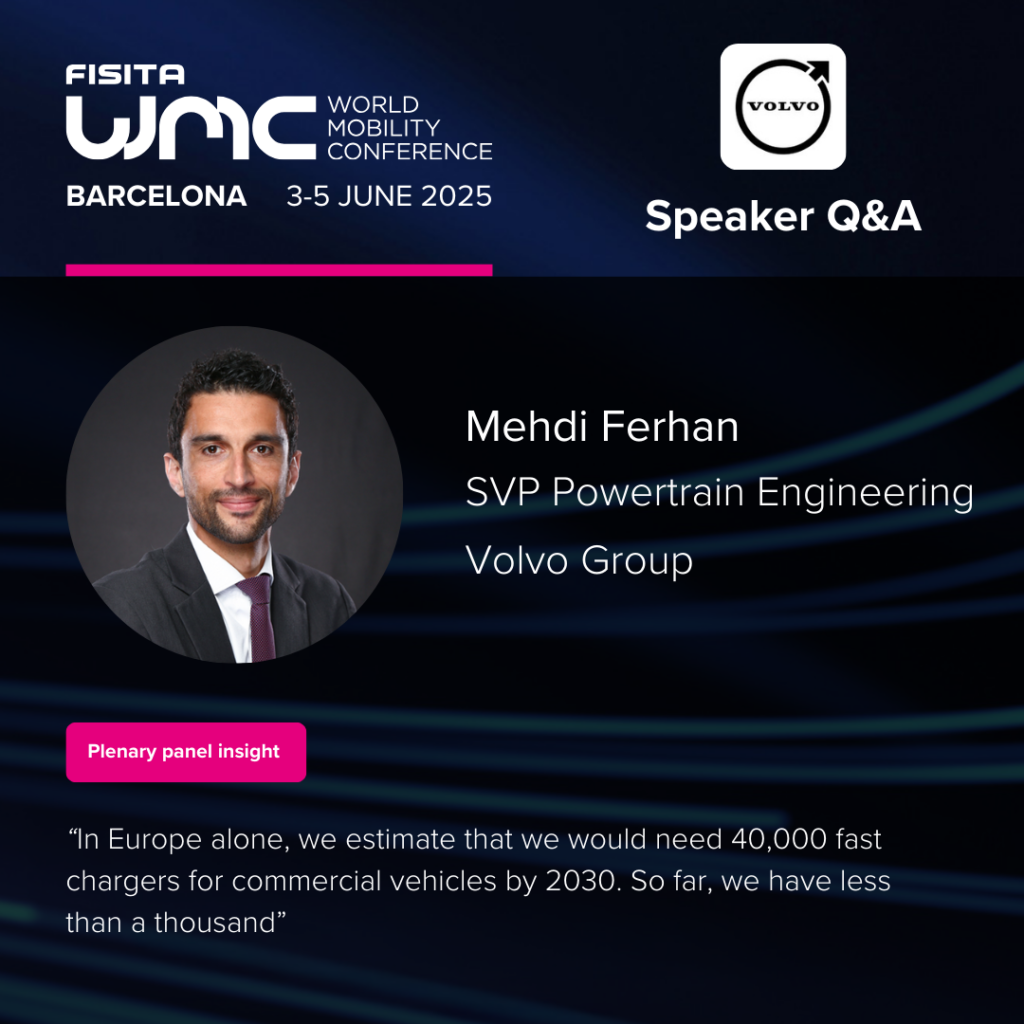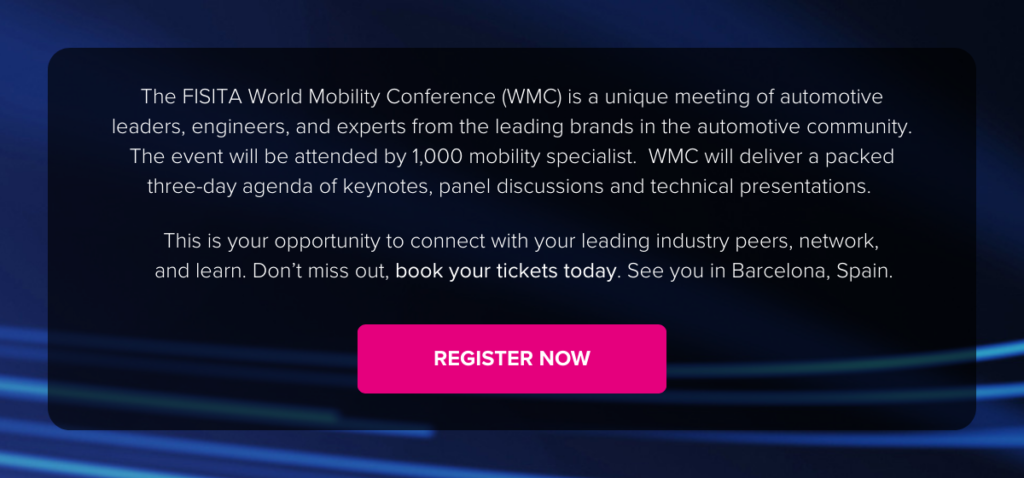Mehdi Ferhan, SVP Powertrain Engineering at Volvo Group, talks to FISITA CTO Martin Kahl about the diversity of propulsion systems, sustainable mobility, and the outlook for powertrain engineering
One of the highlights of the 2025 FISITA World Mobility Conference will be the OEM plenary panel discussion, focusing on the challenges facing vehicle manufacturers, and the opportunities they present.
Mehdi Ferhan is Senior Vice President Powertrain Engineering at Volvo Group. In post since June 2024, he has responsibility for the research and development of truck powertrain technologies for the Volvo Group, which includes Volvo Trucks, Mack Trucks, and Renault Trucks. The Powertrain Engineering division, which boasts around 2,000 engineers located in Sweden, France, Brazil, USA and India, develops a wide portfolio of technologies for Volvo Group’s customers, including combustion engines, electric powertrains and hydrogen fuel cell electric solutions.
In the build-up to his participation in the OEM panel, FISITA spoke to Mehdi about some of the key issues currently facing OEMs, and the opportunities these present.
The future of mobility relies on the sustainable movement of people and goods. What are the most practical and scalable strategies for achieving this transformation globally?
It’s very true that the future of mobility needs to become much more sustainable. At Volvo Group we are pushing the transformation with several technologies developed in parallel as we don’t believe in one single solution to decarbonise our industry. Different transportation sectors need different solutions, whether it’s construction sites, transporting goods, or moving people in buses. I think it’s important to have a pragmatic approach here. The transition needs to be driven by customers’ needs and their use cases.
In Europe alone, we estimate that we would need 40,000 fast chargers for commercial vehicles by 2030. So far, we have less than a thousand
For the commercial vehicle industry there are many parameters to consider, such as access to green energy and infrastructure for charging, as well as local public policies. From a customer standpoint, the total cost of ownership is very important for their business. We believe in bringing technology to the market that matches the capabilities and the needs of the customers. For the most intensive use cases, we know that hydrogen fuel cells can play a role in complementing battery electric solutions.
How do you see the transition to cleaner, more affordable, and equitable mobility playing out in different vehicle segments and in different regions of the world?
In this regard, it is of course interesting to reflect on the main regions, and Asia, Europe and the US are three diverse markets where the transition is taking different shape at different speeds. At Volvo, we have three truck brands in our portfolio, Volvo Trucks, Renault Trucks, and Mack Trucks, and we aim to have the technologies for sustainable transportation available for all three brands.
For battery electric trucks, we are in a leadership position with more than 5,000 trucks out in the market already, mostly in Europe but also with a significant number of electric trucks in North America, so it is obvious that battery electric technology is already meeting the customers’ needs at a reasonable affordable level. Of course, more progress is needed, and infrastructure is clearly one key prerequisite for scaling adoption of battery electric vehicles. In Europe alone, we estimate that we would need 40,000 fast chargers for commercial vehicles by 2030. So far, we have less than a thousand.
Electrification has been a major disruptor for the automotive industry, but the adoption of pure BEVs has been slower than anticipated. How do you expect the matrix of propulsion technologies to evolve in the quest for cleaner mobility?
We see that truck fleets usually take a decade to be renewed, which is why we aim to offer only fossil-free solutions from Volvo Group by 2040, ten years ahead of the 2050 goal. But we must be a bit humble in front of the market and allow the customer to decide and choose what works for them and their needs.
We need to nurture the engineering spirit to push the industry forward in a challenging period of history that sees us addressing sustainability expectations from the market and from customers, while facing a highly competitive landscape and changes in the global economy
The big difference between a passenger car and a truck is the level of utilization of the vehicle. A car is typically in use for less than three percent of the day, spending the remaining 97 percent parked in the garage. A truck will be utilized 80 percent and above. It’s a working tool expected to deliver performance, reliability and affordability for a full working shift.
An interesting aspect is the emotional part. When buying a car, you choose the colour, the design, the seats and so on. When you purchase a truck, you mainly focus on the performance and the monthly cost. On that note, Volvo Trucks recently won the comparison test for the Green Truck Award, a strong testimony of Volvo Group’s commitment to reduce fuel consumption and CO2 emissions, which is ultimately making a big change for fleet owners.
Critical to the future of mobility is the nurturing and development of new generations of mobility engineers. What should incumbent stakeholders do to ensure that this industry cultivates the engineers and the engineering skills required to take this industry forward sustainably and ensure its longevity?
As an engineer myself this topic is dear to my heart. I believe we should continue motivating young engineers to join the transportation and the mobility industry because of the many fascinating fields of engineering. There’s a broad spectrum when developing a vehicle, from aerodynamics to combustion, propulsion, software and mechanical engineering, and more. For a young engineer this is truly a passionate way to start a career. We need more engineers in Europe to join the movement and create advanced technologies.
Different transportation sectors need different solutions…I think it’s important to have a pragmatic approach here. The transition needs to be driven by customers’ needs and their use cases
From a scientific standpoint, the technologies of the commercial vehicle industry are advancing fast. We are now talking about software-defined vehicles, and how we can utilise artificial intelligence to generate digital twins of our vehicles and powertrains to increase the speed of development and further enhance the performance and features of our trucks. This relies on a strong engineering foundation and internally at Volvo Group we are pushing the spirit with engineering career paths for engineers to become true experts in their fields of expertise. We have academic partnerships and connections with engineering schools and scientific communities. FISITA can be a very good relay in the interface between engineers and company needs.
You’re a panellist at the FISITA World Mobility Conference. What will be your key message to delegates?
First, we need to nurture the engineering spirit to push the industry forward in a challenging period of history that sees us addressing sustainability expectations from the market and from customers, while facing a highly competitive landscape and changes in the global economy. This of course requires consistency and a strategic approach as well as a thorough assessment of the different technological paths to make sure that our offerings address customer needs regardless of where they are in the world.
My key messages will focus on propulsion systems and the three-path strategy we are pushing at Volvo Group with battery electric, hydrogen fuel cell electric, and internal combustion engine trucks running on low carbon fuels including hydrogen. We are partnering with different companies to accelerate the transition, one of them being Westport in Canada with which we have formed a joint venture called Cespira for high pressure direct injection, or HPDI technology. This technology is very useful today for our liquefied natural gas trucks and we already have more than 8,000 LNG trucks out on the roads. We are also developing hydrogen combustion systems, and I believe that H2 ICE trucks can play a significant role as a contributor towards sustainable transportation.

